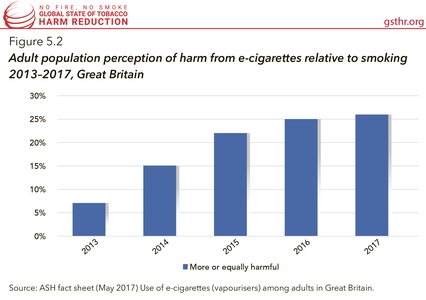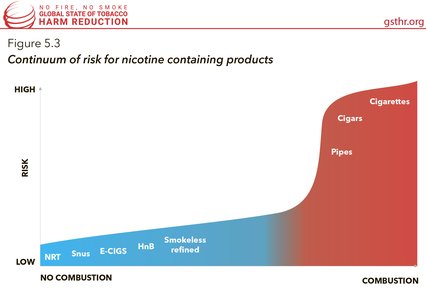Safer Nicotine Products – a Global Picture
Adult Population Perception of Harm from E-Cigarettes Relative to Smoking 2013-2017, Great Britain
- No Fire, No Smoke: The Global State of Tobacco Harm Reduction
Most consumers get their information about SNP (and other health issues, climate change and so on) from the media and friends. Given the extent and focus of media reporting, it is perhaps unsurprising that many people are confused or concerned about SNP. The real concern for harm reduction is that perception of the risk of SNP is actually increasing; more people think (incorrectly) that SNP are as dangerous as cigarettes. In a global survey conducted by the Foundation for a Smoke-Free World, a majority of those polled in 11 of the 13 countries surveyed thought nicotine more harmful to general heath than alcohol, sugar, fat and salt while all those surveyed believed the nicotine in e-cigarettes presented a risk of heart disease and a range of cancers.
In Great Britain, despite the well-publicised findings (cited below) from PHE and the RCP about the relative safety of e-cigarettes, the stop smoking charity Action on Smoking and Health (ASH) found that perceptions of harm concerning e-cigarettes worsened between 2013 and 2017. Over time more people thought that e-cigarettes were more or equally as harmful as smoking, and fewer people thought that they were a lot less harmful.
This infographic refers to the perceptions of e-cigarette safety amongst the population in general, but as ASH stated, more worrying is the worsening perception among smokers:
“The poor understanding among smokers in general about the relative harms of e-cigarettes compared to smoking is of concern […]. The proportion of smokers who think e-cigarettes are just as, or more, harmful than smoking has increased significantly from 9 percent in 2013 to 22 percent in 2017. […] Smokers who have never tried e-cigarettes are less likely to accurately believe they are a lot less harmful than tobacco smoking than smokers who are currently using e-cigarettes. Among smokers who have never tried an e-cigarette, one in three (30 percent) believe e-cigarettes are more or equally harmful as smoking. This is a view that has grown over time among smokers who have not tried an e-cigarette with 25 percent holding this opinion in 2016.”
In the USA, the perception among smokers that e-cigarettes were as, or more harmful than, cigarettes jumped from 11.7 percent in 2012 to 35 percent in 2015 while a belief that e-cigarettes were addictive went from 25.3 percent to 56 percent.
See also p. 61 of the report: No Fire, No Smoke: The Global State of Tobacco Harm Reduction 2018 — Global State of Tobacco Harm Reduction (gsthr.org)
Continuum of Risk for Nicotine Containing Products (2018)
- No Fire, No Smoke: The Global State of Tobacco Harm Reduction
Just how much less harmful are SNP than cigarettes is a matter of scientific assessment and science communication. The risk continuum is one way of communicating the differences in risk when using different kinds of nicotine-containing products. The problem in trying to compute a risk continuum, and then communicating this, is that there are hundreds of different measures that could be considered, derived from laboratory studies, clinical studies of short-term health impacts, through to long-term epidemiological studies.
Two landmark reviews brought the evidence together on e-cigarettes and have been published in the UK, from Public Health England and the Royal College of Physicians. The first key point is that there are no circumstances in which it is safer to smoke than to use e-cigarettes.
Their headline conclusions are:
» Vaping is substantially safer than smoking;
» People who switch from smoking to vaping can experience an improvement in respiratory health;
» Switching to vaping can help people quit smoking;
» There are currently no known long-term adverse health effects due to vaping;
» There is no evidence that young people who experiment with e-cigarettes will become regular cigarette smokers.
The more cautious and conditional evidence review from the US National Academy of Sciences, The Public Health Consequences of E Cigarettes (2018), stated nonetheless: “There is conclusive evidence that completely substituting e-cigarettes for combustible tobacco cigarettes reduces users’ exposure to numerous toxicants and carcinogens present in combustible tobacco cigarettes”.
And while opposed to SNP, the WHO briefing on e-cigarettes conceded that “it is very likely that average ENDS use produces lower exposures to toxicants than combustible products”.
Public Health England has asserted that “based on current knowledge, stating that vaping is at least 95% less harmful than smoking remains a good way to communicate the large difference in relative risk unambiguously…”. This means that e-cigarettes are not totally harmless, but that the appropriate scientific approach is to compare their safety (and all SNP) relative to combustible cigarettes, rather than examine the absolute safety of the products in isolation.
In other words, harm reduction, not harm eradication.
See also p. 62 of the report: No Fire, No Smoke: The Global State of Tobacco Harm Reduction 2018 — Global State of Tobacco Harm Reduction (gsthr.org)
Countries Where Heated Tobacco Products Are Marketed
- Burning Issues: The Global State of Tobacco Harm Reduction 2020
In line with many high-income countries, Japan has seen significant declines in daily adult smoking rates, although it is behind in public smoking bans, preferring instead to have designated smoking areas. Japan toughened up laws in major cities like Tokyo ahead of the 2020 Olympic Games (now postponed until 2021), although protecting bystanders from second-hand smoke has been more driven by etiquette than legislation. Japanese smokers often carry ashtrays with them in order not to inconvenience others and to reduce litter. Given this culture of manners regarding smoking, it might have been expected that the authorities would have taken a reasonably liberal approach to safer nicotine products (SNP). But as nicotine is listed as a poison, it means that vaping e-liquid is not allowed unless approved as a medicinal product, although devices and non-nicotine liquids are on sale. By contrast, rather than being the responsibility of the health ministry, heated tobacco products (HTP) are controlled by the Ministry of Finance and are widely available. HTP devices have seen a dramatic rise in popularity among young smokers – with a consequential steep fall in cigarette sales – both because of the technological novelty and because HTP play to the culture of manners.
In contrast, South Korea is a tragic example of a country which has gone backwards in relation to THR. The main domestic tobacco company KT&G was a government monopoly until privatisation, since when it has pushed on with an ambitious growth plan. But with the arrival of SNP and in particular HTP, cigarette sales in South Korea went into reverse. Since smoking was banned indoors at places like restaurants and cafés in 2015, South Korea has become less tolerant of smokers. Meanwhile vaping products have been gaining popularity in the country’s $16 billion tobacco market since 2017. By June 2019, vaping products accounted for 13 per cent of South Korea’s nicotine market by sales, while for HTP, the country is currently the world’s second largest market after Japan, worth $1.7 billion.
Unfortunately, the government has been influenced by the WHO and internal anti- THR elements – issuing warnings about SNP amid proposals to impose bans. The consequence of smokers being warned about the ‘dangers’ of vaping is that the rate of decline in cigarette sales has slowed. This can only benefit traditional cigarette companies and a government more concerned about falling tax revenue or damage to a domestic tobacco industry or both. Of course, this is a consequence of a more prohibitionist approach to SNP not limited to South Korea.
For the latest information about HTPs in different countries, see the GSTHR Nicotine FAQ section.
See also p. 129 of the report: Burning Issues: The Global State of Tobacco Harm Reduction 2020


